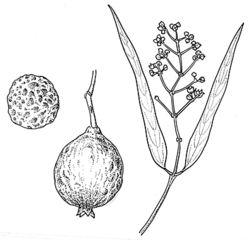Family:
Santalaceae
Santalum acuminatum
Quandong
Other Names:
Regional Subspecies:

Habitat & Site Selection:
Various woodland communities, on sandy sites or gravelly ridges. Sandy, well drained loamy and clayey soils. Tolerates drought and most frosts. Local observations suggest some tolerance of salinity.
Habit:
Erect, spindly shrub or small, shapely tree to 6m high. Spreading to drooping branches, and sparse pale to olive-green narrow leaves 3-9cm long, in opposite pairs. Flowers are whitish-cream (Sep-Feb).
Seed Collection & Propogation:
Early Aug to late Nov. Monitor closely as seed drops quickly upon ripening. Propogate from seed. Before sowing, soak fruits in mild bleach solution for 30 minutes, then wash thoroughly in water. Sow fruits whole, or to hasten germination, gently crack to remove outer shells. Place nuts into sealed plastic bag with moist vermiculite and a small amount of fungicide. Store at 16-25?C. Seeds will germinate in 1-2 months. Carefully remove seeds when roots are about 1cm long and plant in large containers. Plant seedlings in 12 months with host plants, such as native grasses. Alternatively, plant seeds directly over host roots. Parasitic on roots of other plants, at least when young. Regenerates from suckers and seeds. Not suitable for direct seeding.
Values & Uses:
Long lived. Medium level shelter. Heartwood hard, close grained, and flesh coloured. Sapwood creamy-pink. Emits pleasant fragrance when freshly cut. Excellent for cabinet work, taking fine polish. Insects feed on the fruits and foliage. Koories ate both fruit and seed. Scarlet, acidic fruit pulp, rich in vitamin C was favoured. Dried fruit from beneath trees soaked in water, or fashioned into cakes for storage. Oily seeds eaten, or ground to make an ointment for curing ailments of the scalp. Wood used to make fire. Textured seeds currently used to craft jewellery. Attractive shrub when in fruit. Fruit makes good preserves.
